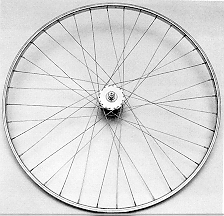| |
In systems
such as a bicycle, some components rotate about a fixed shaft. The wheel
shown in the photograph is an example of such a component. When the center
of mass of the wheel is stationary (i.e. the hub is fixed in position) the wheel
may still rotate about the hub and there will be momentum and kinetic energy
associated with this angular motion. If the wheel is rolling on a horizontal
table it will also have momentum and kinetic energy associated with the
linear motion of its center of mass.
From Newton's laws, if a force acts
on the center of mass of the wheel, it will accelerate and its linear momentum,
mv, will change.
The translational kinetic energy, Ttrans = (mv2/2), associated with
the motion of the center of mass will also increase as the velocity increases.
If the wheel is subjected to a moment, M, about the axle it will have a change in angular
velocity and its angular momentum at a given angular velocity, w
radians/sec, will be H =
Iw, where I is the moment of inertia
of the wheel. At this angular velocity the wheel's rotational kinetic energy
will be T
rot = (Iw2/2).
The
angular equivalent of Newton's second law relates the moment acting on
the wheel to the rate of change of its angular momentum, viz: M = (dH/dt) = I (dw/dt) . |
|
|
|
|
|
|
|
|
|
